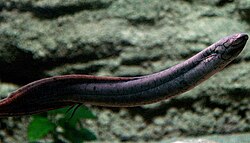ミナミアメリカハイギョ (学名:Lepidosiren paradoxa 、レピドシレン・パラドクサ)は、ハイギョ目 ミナミアメリカハイギョ科 の魚。
ミナミアメリカハイギョ科 は単型 。
アフリカハイギョ科 と近縁で、前期白亜紀 に分化したと考えられている。同じ科に含む見解もあるが、多くの場合別の科に分類される[ 5] [ 8] [ 9]
南アメリカ大陸 のアマゾン川 流域、パラグアイ 、パラナ川 流域に分布する。流れの穏やかな川 や沼 に生息する[ 10]
幼体は黒く、金色の斑点が入る。成体は茶色や灰色になる[ 11] 前上顎骨 と上顎骨 が融合している。体はウナギ のように細長く、全長は125 cmに達することもある[ 10] [ 12] [ 13]
幼体は水生昆虫 や貝 を、成体はその他にも藻類 や甲殻類 を歯板で砕いて捕食する。乾季には泥の中に潜り、約30 - 50 cmの深さに部屋を作り、呼吸のために表面にいくつかの穴を空けて休眠 を行う[ 13] [ 11] 肺 の機械受容器 の進化により、干ばつ と洪水の両方に適応できる[ 14] [ 15] 胚 はオタマジャクシ に似ており、4 つの鰓がある。巣内に酸素を供給する為、雄は腹鰭の器官から水中に酸素を放出する[ 13] イモリ のような鰓がある[ 11] 恐竜 が絶滅した白亜紀と古第三紀の間の大量絶滅 の直前、7200万年前から6600万年前のマーストリヒチアン から発見されている[ 1]
^ a b “Lepidosiren Fitzinger 1837 (South American lungfish) ”. PBDB . 2024年2月18日 閲覧。
^ Frederico, R.G. (2022). “Lepidosiren paradoxa ” . IUCN Red List of Threatened Species 2022 : e.T49830702A159889457. doi :10.2305/IUCN.UK.2022-2.RLTS.T49830702A159889457.en . https://www.iucnredlist.org/species/49830702/159889457 18 February 2024 閲覧。 ^ Part 7- Vertebrates オリジナル の5 October 2016時点におけるアーカイブ。. https://web.archive.org/web/20161005114629/http://mave.tweakdsl.nl/tn/genera7.html 30 June 2016 閲覧。 ^ Haaramo, Mikko (2007年). “Ceratodiformes – recent lungfishes Mikko's Phylogeny Archive . 3 July 2016 閲覧。 ^ a b “FAMILY Details for Lepidosirenidae - Aestivating lungfishes ”. www.fishbase.se . 2023年3月29日 閲覧。
^ Ernst Heinrich Philipp August Haeckel; Edwin Ray Lankester; L. Dora Schmitz (1892). The History of Creation, Or, The Development of the Earth and Its Inhabitants by the Action of Natural Causes: A Popular Exposition of the Doctrine of Evolution in General, and of that of Darwin, Goethe, and Lamarck in Particular : from the 8. German Ed. of Ernst Haeckel . https://books.google.com/books?id=ltUj8vk3auEC ^ Konrad Guenther; Bernard Miall (1931). A Naturalist in Brazil: The Record of a Year's Observation of Her Flora, Her Fauna, and Her People 399 . https://archive.org/details/naturalistinbraz00guen ^ Kemp, Anne; Cavin, Lionel; Guinot, Guillaume (2017-04-01). “Evolutionary history of lungfishes with a new phylogeny of post-Devonian genera” (英語). Palaeogeography, Palaeoclimatology, Palaeoecology 471 : 209–219. Bibcode : 2017PPP...471..209K . doi :10.1016/j.palaeo.2016.12.051 . ISSN 0031-0182 . ^ Brownstein, Chase Doran; Harrington, Richard C; Near, Thomas J. (2023-04-12). “The biogeography of extant lungfishes traces the breakup of Gondwana” (英語). Journal of Biogeography 50 (7): 1191–1198. doi :10.1111/jbi.14609 . ISSN 0305-0270 . https://onlinelibrary.wiley.com/doi/10.1111/jbi.14609 . ^ a b Froese, Rainer and Pauly, Daniel, eds. (2024). "Lepidosiren paradoxa " in FishBase . April 2024 version.
^ a b c Animal-world: South American Lungfish.
^ "Your Inner Fish" Neil Shubin, 2008,2009,Vintage, p.33
^ a b c Bruton, Michael N. (1998). Paxton, J.R.; Eschmeyer, W.N.. eds. Encyclopedia of Fishes . San Diego: Academic Press. p. 70. ISBN 0-12-547665-5
^ MESQUITA-SAAD, L. S. B.; LEITÃO, M. A. B.; PAULA-SILVA, M. N.; CHIPPARI-GOMES, A. R.; ALMEIDA-VAL, V. M. F. (August 2002). “Specialized metabolism and biochemical suppression during aestivation of the extant South American lungfish --Lepidosiren paradoxa”. Brazilian Journal of Biology 62 (3): 495–501. doi :10.1590/s1519-69842002000300014 . ISSN 1519-6984 . PMID 12530187 . ^ de Moraes, Marcos F. P. G.; Höller, Sabine; da Costa, Oscar T. F.; Glass, Mogens L.; Fernandes, Marisa N.; Perry, Steven F. (July 2005). “Morphometric Comparison of the Respiratory Organs in the South American Lungfish Lepidosiren paradoxa (Dipnoi)” (英語). Physiological and Biochemical Zoology 78 (4): 546–559. doi :10.1086/430686 . ISSN 1522-2152 . PMID 15957109 . http://www.journals.uchicago.edu/doi/10.1086/430686 .

